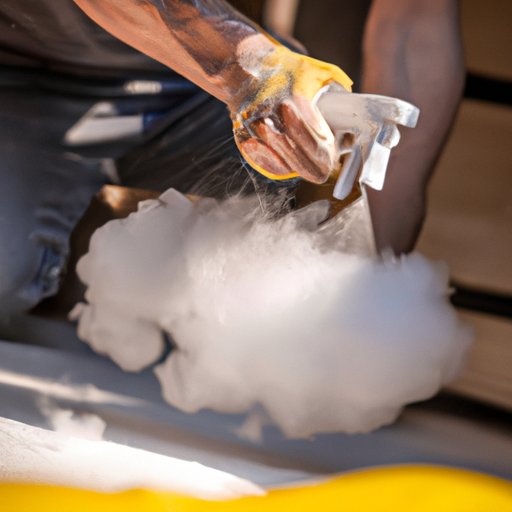
I. Introduction
Spray foam is a useful material for many DIY projects, but it’s not so useful when it ends up on your skin. Not only can it be an irritation or safety hazard, but it’s also just plain frustrating to try and get it off. With this comprehensive guide, you’ll learn how to remove spray foam from your hands using a range of household and professional solutions.
II. Preventing Spray Foam Contact with Skin
The best way to deal with spray foam on your skin is to prevent it from happening in the first place. When working with spray foam, taking precautions such as wearing gloves and protective clothing can help keep the foam from touching your skin. Additionally, a barrier cream can be applied to the skin, creating a physical barrier between the foam and your skin.
III. What to Do When You Get Spray Foam on Your Hands
If you do end up getting spray foam on your hands, it’s crucial to address it quickly. Here’s a recommended method for removing spray foam from your hands:
Step 1: Use a Paper Towel or Scraper
Remove as much of the excess foam as possible. If the foam has hardened, you may need to use a scraper to gently scrape it off your skin.
Step 2: Apply a Solvent
Soften the remaining foam by applying a solvent such as nail polish remover or rubbing alcohol to the affected area. Be sure to apply the solvent directly to the foam and not the surrounding skin.
Step 3: Wash with Soap and Water
After the foam has softened, wash the affected area with soap and water. You may need to repeat this process several times to fully remove the foam.
IV. 5 DIY Solutions for Removing Spray Foam from Your Hands
If you don’t have a solvent on hand, or if you’re looking for a more natural solution, there are several household items that can be used to remove spray foam from skin. Here are five effective DIY solutions:
Nail Polish Remover
Soak a cotton ball or swab with nail polish remover and apply it to the affected area. The acetone in the nail polish remover will help dissolve the foam.
Rubbing Alcohol
Apply rubbing alcohol to the affected area and let it sit for a few minutes. Then, use a paper towel or cloth to wipe away the softened foam.
Vinegar
Soak the affected area in white vinegar for several minutes, then use a cloth or paper towel to remove the softened foam.
Coconut Oil
Gently rub coconut oil onto the affected area, then use a cloth or paper towel to wipe away the foam. Coconut oil is moisturizing and can help soothe the skin after exposure to spray foam.
Olive Oil
Saturate a cotton ball or cloth with olive oil and apply it to the affected area. The oil will help soften the foam, making it easier to wipe away.
V. Professional Tips for Removing Spray Foam from Your Hands
If you’re working with spray foam frequently, or if you’re struggling to remove large amounts of foam, it may be helpful to seek the advice of professionals. Here are some tips from the experts:
Use a Handheld Scraper
For larger amounts of foam, a handheld scraper can be more effective than a paper towel or cloth. Be sure to use a plastic scraper to avoid damaging the skin.
Try a Professional Solvent
There are several professional-grade solvents that can be used to remove spray foam from skin, such as Goof Off or Goo Gone. These solvents are more powerful than household remedies, but they can be harsh on the skin and should be used with caution.
Don’t Use Hot Water
Contrary to popular belief, hot water can actually make it harder to remove foam from the skin by causing the foam to expand. Instead, use cold or lukewarm water to rinse the affected area.
VI. Common Mistakes to Avoid When Removing Spray Foam from Hands
It’s important to approach the process of removing spray foam from your hands with care. Here are some common mistakes to avoid:
Using Harsh Chemicals or Abrasive Tools
Certain chemicals or tools can be harmful to the skin, so take extra care when experimenting with different removal methods. Avoid using harsh chemicals or abrasive tools like sandpaper, which can cause skin irritation or damage.
Using Hot Water
As mentioned earlier, hot water can make the foam harder to remove. Avoid the temptation to use hot water, even if it seems like it would be more effective at first.
VII. Conclusion
While getting spray foam on your hands can be frustrating, there are a variety of solutions available to help remove it safely and effectively. Whether you opt for a DIY solution or seek professional advice, taking preventative measures and approaching the removal process with care will help ensure that the experience is as painless as possible.




